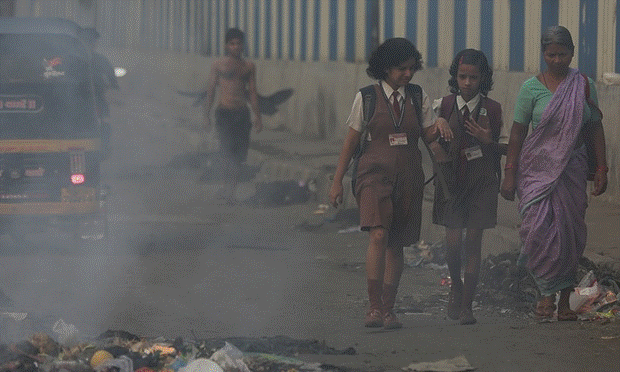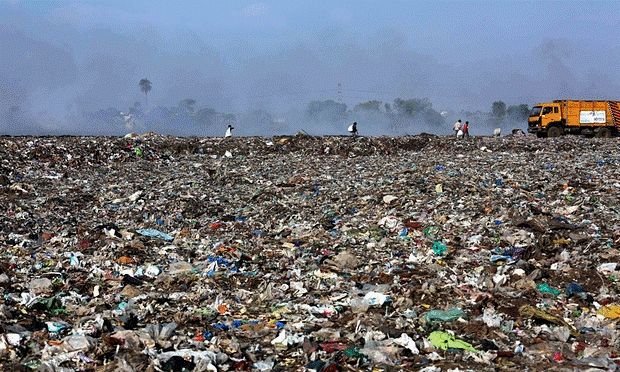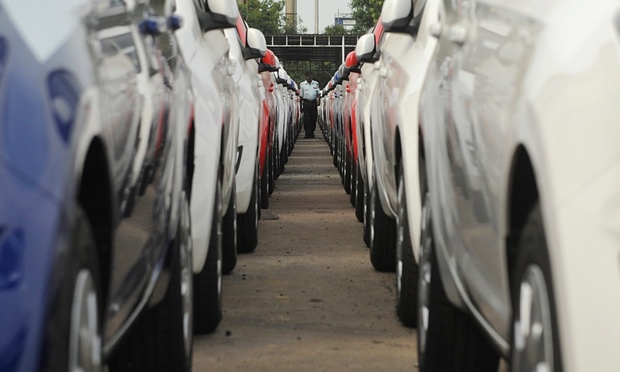India's doctors blame air pollution for sharp rise
in respiratory diseases
印度的医生谴责空气污染导致呼吸疾病的迅速增加
Cases are up 30% since 2010 in country where decline in air quality is shifting
from acute to chronic in more than just Delhi 从急性转为慢性病

Schoolgirls walk past burning rubbish in Mumbai. India has the highest rate
of death from respiratory disease in the world, says the WHO. Photograph: Rafiq
Maqbool/AP
Jason Burke in Delhi and Chennai孟买的学生路过一堆燃烧的垃圾
Wednesday 23 September 201516.34 BSTLast modified on Thursday 24 September
201500.01 BST
A sharp rise in cases of chest and throat disease in India is being blamed by
doctors on worsening air pollution in the country, which is now home to 13 of
the 20 most polluted cities in the world.印度的空气污占全球最差20个城市当中占13个
According to India’s National Health Profile 2015, there were almost 3.5m reported
cases of acute respiratory infection (ARI) last year, a 140,000 increase on
the previous year and a 30% increase since 2010. 急性呼吸道感染
The number of ARI cases has risen steadily in India over the last 15 years,
even when population growth is taken into account. In 2001, less than 2,000
cases per 100,000 people had an ARI. In 2012 the number was 2,600 per 100,000,
statistics show. 十万人当中有2600人得了急性呼吸道干染
The rise has occurred despite steady improvements in medical care and nutrition,
as well as a shift away from using wood as fuel in rural areas. Together this
has mitigated many factors long blamed for the high levels of respiratory diseases
in India.不要烧木材作为燃料了
Doctors are blaming the increasing severity of the problem on unprecedented
decline in air quality across India.
“Due to the awareness drives conducted about diseases like swine flu and influenza,
people have become more aware ... Yet air pollution is playing a major role
in [increasing] the numbers of such diseases,” Dr Jugal Kishore, head of community
medicine at Delhi’s Safdarjung hospital, told the local India Today news magazine.
Attention to the problem of air pollution in India has so far focused almost
exclusively on the capital. One study found that half of Delhi’s 4.4 million
schoolchildren would never recover full lung capacity.德里的4百4十万小学生从来没有最大化使用其肺活量

Thick smog hangs over the Red Fort in Delhi. Photograph: Raveendran/AFP/Getty
Images 德里红堡的烟雾
But the rest of India has received less attention, though in many cases the
problem is almost as acute, or possibly worse. The latest government figures
show high numbers of lung and throat infections in the eastern state of West
Bengal, the central state of Andhara Pradesh, as well as in tourist favourites
Kerala and Rajasthan.肺部和咽喉感染在孟加拉邦
Mumbai also has pollution levels which, though lower than in Delhi, exceed safe
limits set by the Indian government many times. Those limits are significantly
higher than those set by international experts and western governments.
This summer, some reports suggested that Chennai experience worse pollution
than anywhere else in India. Though the data has been challenged, it is clear
that the levels of hazardous gases such as carbon monoxide, nitrogen dioxide
and ozone, as well as of deadly fine particulates, in the southern city have
consistently breached the World Health Organisation’s maximum safe limit. 就是AQI空气质量指数的6个项目(一氧化碳
CO,二氧化氮 NO2,二氧化硫 SO2,臭氧 O3 ,PM2.5/10传感器)
“I always thought there was some washing off of pollution here due to the coastal
breeze. But that seems to be wishful thinking,” said Prof Sudhir Chella Rajan,
a specialist in urban air pollution at the Indian Institute of Technology Chennai.
Campaigners point out that the focus on Delhi has distracted from problems elsewhere.
“Some reports are alarmist but in general, for sure, parts of Chennai are definitely
worse than Delhi,” said Shweta Narayan, an activist.
Other major regional centres, such as Mumbai, Bangalore, or Bhopal are also
badly affected.
“The older parts [of the Bhopal] have horrendous air. There’s no mass transit
system, lots of very old substandard vehicles, open fires. It’s very serious,”
said Nityanand Jayaraman, an environmental campaigner who regularly visits the
Madhya Pradesh capital. 不合格的汽车, 露天燃烧.

A landfill, in Bhopal, India. Photograph: Sanjeev Gupta/EPA垃圾填埋场
A report this summer highlighted the damage air pollution is causing the famous
Golden Temple in Amritsar,Punjab.
Blackspots within individual cities around India are rarely identified by official
figures, either on the prevalence of respiratory illness or air quality.
The worst affected areas of Chennai, which has a population of around 4 million
people, lie on its northern rim, where petrochemical works, car factories and
coal-burning power stations exist close to residential areas. In July, levels
of deadly PM2.5 particulates in the Manali neighbourhood were four times the
WHO safe limit. These particulates lodge in the lungs and allow heavy metals
to enter the bloodstream. PM2.5是WHO要求的4倍,位于肺部,导致重金属进入血管
In other cities across the country the problem was even worse. In Ahmedabad,
in the west, levels of PM2.5s peaked at eight times the WHO limit for a 24-hour
average. In Lucknow, in the north, levels reached seven times the limit. Levels
of CO2, nitrogen dioxide and ozone in less known cities have also regularly
exceeded WHO guidelines by huge margins. 不同的城市超标八倍, 七倍
India has the highest rate of death from respiratory disease in the world, according
to the WHO,. The rate was 159 per 100,000 in 2012, about 10 times that of Italy,
five times that of the UK and twice that of China. 印度的呼吸疾病全球最高,
是中国的两倍, 英国的5倍,意大利的10倍.
Officials in Chennai say they are aware of the problem, and point to measures
from the new $3bn (£2bn) metro to the construction of traffic islands as evidence
of their intent to tackle it.解决办法之一是建地铁
But similar mass transit systems across India do not have a significant immediate
impact on pollution, experts say. Most are too small and have been built too
late. Studies show that Delhi’s metro users previously travelled on buses, by
bicycles or on foot, not in cars.
One effective, and considerably cheaper, scheme in Chennai has been the introduction
of minibuses on smaller roads between the major bus routes. “It has worked and
been very popular,” said Narayan.
The problem has a broader cultural aspect too. In India, as in the west in the
1950s and 1960s, cars bring not just mobility and convenience but are tangible
symbols of social success.
On a sheet of paper pinned to a wall of the spotless Alandar station, contented
passengers have scrawled their impressions of Chennai’s month-old metro. “Very
wonderful, fantastic, unforgettable,” they gush.
Natarajan Ramesh, an off duty policeman buying a ticket in the station’s cavernous
entry hall, was also impressed. “It is very nice. It is the need of the hour.
It will help commuters travel in such a quick span of time and is very clean
too,” he said.

Employee walks between parked cars ready for shipment at a port in the southern
Indian city of Chennai. Photograph: BABU/Reuters出厂前的汽车
However, Ramesh’s own ambitions are less environmentally sensitive. “My dream
is to have a car,” he said. “Trains are all nice and useful but not the same
as a car. I would like a Honda, or maybe a Volkswagen.”
The number of vehicles, including motorbikes, on Chennai’s roads has more than
trebled in 15 years. In Delhi and many other cities the increase has been even
greater. Hundreds of smaller towns, for which there are no reliable air quality
figures available, have horrific congestion and pollution from ageing power
stations and poorly regulated industry. 老化的电站和管理很差的工业有空气污染

Smoke rises from brick kiln chimneys on the outskirts of Delhi. Photograph:
Altaf Qadri/AP 砖窑厂烟囱冒出的烟雾
There is still hope for improvement, though only in the long term. Officials
in India no longer deny there is a problem and air pollution is fast becoming
a significant political issue for many wealthier urban residents. 在富人住宅区,空气污染成为了一个政治问题
On Tuesday, a joint initiative by police and local businesses led to a “car
free day” in Gurgaon, a satellite city of Delhi. Though only a limited number
of roads were shut, pollution levels dropped dramatically, local newspapers
reported. 无车日迅速降低了污染
Pollution expert Raja worked for five years at the Californian Air Resources
Board. The air in the US state, once infamous for its smoggy cities, is now
cleaner than in decades, even though problems remain.
“They have done an enormous amount … but it took 40 years. Here [in India] air
pollution is probably going to be very severe for a couple of decades before
it gets any better,” he said. 美国花了40年治理空气仍然有问题,印度还有很长的路走




